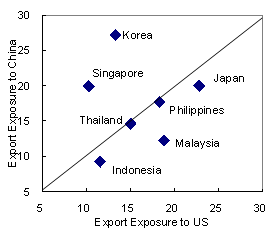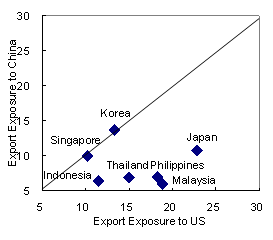Asian economies are better placed than some developed ones to cope with the global slowdown, but they are not immune.
If there was ever any doubt, it is now clear that Asia will not be entirely spared from the effects of the global economic slowdown. The projections by the IMF for the region have been revised downward and, according to the latest estimates, real GDP growth in 2009 will be fully three percentage points below the rates recorded in 2007 with about half of the decline occurring in the current year. That said, Asian economies will continue to grow even as Europe and the US are projected to be in recession.
This close link between the economic fortunes of the region and those of the United States and Europe stands in sharp contrast to predictions made, in some cases only a few months ago, by those who adhered to the so-called decoupling theory, according to which increasing intra-Asia trade in the past five to ten years has made the local economies less dependent on trade with the rest of the world. Some even argued that Asia could replace, or at least supplement, the developed economies as an engine of growth of the world economy. A closer look at the data reveals a somewhat different picture.
Many readers will already be aware that much of the increase in intra-Asia trade consists of trade in intermediate goods which are used as inputs in the production of goods for export to the US, Europe and other OECD economies. Mainland China is a crucial link in this production chain. But the quantitative importance of this factor is perhaps less well known. Research at the HKMA using detailed firm-level data provides some useful perspective. Chart 1 below compares the direct export exposure of a number of economies in the region to China on the one hand and the US, as a representative of the external markets, on the other. This chart shows, for example, that the bilateral exports of Thailand to China as a percentage of Thailand's total exports are as large as its exports to the US, both being around fifteen percent. But things look rather different when the figures are adjusted to reflect the portion of Thailand's exports to China that are re-exported to the US after processing. Chart 2 indicates that the exposure to China falls dramatically, which of course means that as a source of final demand for the region's export production, the US (and other OECD economies) continues to be dominant.
But the exposure of the region to the economic fortunes of the rest of the world is not only determined by trade flows. As the current financial turmoil is reminding us, if indeed we needed to be reminded, financial market linkages across the world are such that a disturbance in one part of the system will rapidly spill over to other parts, at least those that are relatively open to international capital movements. While the banking systems in Asia were not greatly exposed to sub-prime assets and therefore were only marginally affected by the initial write-downs in the values of these assets, other transmission mechanisms of financial fragility have continued to operate. As liquidity dried up in US and European money markets, financial institutions turned abroad for short-term funding, thus affecting money markets in other financial centres, including Hong Kong. As deleveraging of financial institutions in New York, London, and Frankfurt led to liquidation of asset portfolios, funds started to flow out of emerging markets bringing about reductions in asset prices and the need for deleveraging on the part of financial institutions in this part of the world as well. The credit crunch in the United States and Europe is thus affecting emerging markets too.
So even though the current financial crisis originated far from Asia, Asian economies are still feeling the consequences in terms of a slowdown in economic growth and varying degrees of financial distress. To be sure, the prudent fiscal, monetary, and financial policies that were implemented after the crisis ten years ago have made the economies in the region much more resilient and able to take countercyclical policy measures, such as those that have been announced by the authorities on the Mainland as well as in Japan and Korea. While these measures will make an important contribution to the region as a whole, our integration with and dependence on the wider world economy is such that we must hope that the pledge made by all G-20 leaders at their meeting last weekend in Washington will be followed up by concrete actions to stabilise the world’s financial markets, to stimulate aggregate demand for goods and services, and to keep an open international trading system.
| Chart 1: Direct Export Exposures 2006 |
Chart 2: True Export Exposures 2006
(Including both direct and indirect export exposure)
|
 |
 |
Hans Genberg
20 November 2008
Click here for previous articles in this column.
Document in Word format



